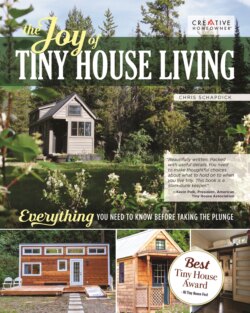Читать книгу The Joy of Tiny House Living - Chris Schapdick - Страница 13
WHY ARE PEOPLE GOING TINY?
ОглавлениеTiny represents different things to different people at different points in their life. Here I’ll define what it tends to mean for different age brackets and demographics.
Tiny houses have a specific appeal for younger people, people who are coming out of college or maybe just starting off down a career path. Going tiny represents an affordable accommodation during a period when financial stability might not yet be established or possible. Younger adults coming out of college may be in debt from paying for their education. Taking on additional debt in the form of a 30-year mortgage does not appeal to these young adults. This younger generation is gravitating toward smaller, more affordable housing, given that the large urban centers in the United States and elsewhere are experiencing affordable housing crises.
This small, towable home would appeal to many members of the younger generation, who are often motivated to go tiny because the cost is considerably cheaper than a 30-year mortgage.
Tiny houses (and other alternative structures such as buses, yurts, or vans) therefore become a natural and clear alternative to traditional living for young people. When you combine the affordability with the ability to easily relocate a tiny house—to move it wherever the work is—it is an appealing proposition. More and more professions and jobs can be executed remotely, and this is another reason why living in a tiny house is a good alternative. According to a Gallup survey, more than 43 percent of workers did some of their work remotely in 2018. This trend keeps going up year after year. That tiny house can be situated virtually anywhere, as long as the person has access to the Internet and to power and therefore can perform any number of different job functions.
Tiny houses are an opportunity to rethink what it means to have a home.
For people who are middle-aged, tiny living represents many of the same benefits. But there are also certain life situations in middle age that make living tiny more viable. People in the middle of their lives often go through major life transitions, like the dissolution of a marriage (according to Pew Research Center, divorce rates consistently hover just below 50 percent), or a new career with different needs. There are many reasons why someone might be looking to downsize and save money in their thirties and forties. Plus, the same benefits of mobility and remote work that apply to the younger generation certainly hold true for middle-aged folks as well.
When you get to the older generations, many people may be looking to downsize or travel more. Their children may have moved out of the house, and now they’re living either by themselves or with a partner in a house that has outgrown their needs. Downsizing, the empty nest phenomenon, saving money, and being able to relocate are main drivers for folks in their fifties, sixties, and even seventies.
Cutting across all of these generational aspects is the element of people rethinking what it means to have a house. The standard notion of traditional housing doesn’t really appeal to everyone anymore. You may be living in a space not really designed for your personal needs. The tiny house movement is founded on creating a personalized space and building only what you need. When you build according to your vision, and not someone else’s, you invariably create something that is uniquely your own. Homes have always been an expression of who we are; we decorate them a certain way, we fill them with certain furniture, and we paint them certain colors. Tiny houses take it a step further: not only can you personalize the decoration and the fixtures, but also the entire design. It’s your vision, not someone else’s, and this element of customization is a really appealing notion for people of any age.
One of the other benefits—and some people’s main goal—of going tiny is that you are lowering your carbon footprint. We all have an impact on this planet, and being able to reduce that in some fashion can be appealing. Another great by-product of the tiny movement is that people who have gone tiny tend to have more disposable income. For most tiny house owners, this disposable income will not be spent on acquiring more consumer goods, but rather on gaining new experiences. (I cover this in more detail on here.)
One reason that anyone, at any age, may be motivated to build a tiny house is that, unlike in traditional housing, every aspect of it is customizable. For example, I made these unique mock shutters to decorate the windows on one of my houses.
Solar panels and other forms of renewable energy can help reduce your carbon footprint in a tiny house.
